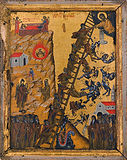

| Previous day | Next day |
| Old Style
March 30
|
Friday |
New Style
April 12
|
|
5th Week of Great Lent.
Tone 4.
Great Lent. |
Monastic rule: xerophagy (bread, uncooked fruits and vegetables).
|
![]() St. John Climacus of Sinai, author of The Ladder (649).
St. John Climacus of Sinai, author of The Ladder (649). ![]() St. Sophronius, bishop of Irkutsk (1771).
St. Sophronius, bishop of Irkutsk (1771).
Prophet Joad, who dwelt in Bethel (10th c. b.c.). Holy Apostles Sosthenes, Apollos, Cephas, Caesar, and Epaphroditus, of the Seventy (1st c.). St. Eubula, mother of St. Panteleimon (ca. 305). St. John the Silent, of St. Sabbas Monastery (6th c.). St. Zosimas, bishop of Syracuse (ca. 662).
St. John the Hermit, of Cilicia (4th c.). St. John II, patriarch of Jerusalem (5th c.). St. Osburga of Coventry, virgin (ca. 1015). New Hieromartyr Zachariah, metropolitan of Corinth (1684). St. Gabriel, metropolitan of Kishinev and Khotin (Moldova) (1821).
Repose of Blessed Matrona (Mylnikova) the Barefoot, of St. Petersburg (1911).
Articles
 Prophet JoadHoly Prophet Joad came from Samaria and prophesied during the tenth century before Christ (See 1/3 Kings 13). |
 Apostle Sosthenes of the SeventySaint Sosthenes was head of the Corinthian synagogue before his conversion. |
 Apostle Apollos of the SeventySaint Apollos assisted the Apostle Paul. |
 Apostle Cephas of the SeventyAccording to Tradition, Saint Cephas was Bishop of Iconium. |
 Apostle Caesar of the SeventyThe Holy Apostles Sosthenes, Apollos, Cephas, Caesar and Epaphroditus of the Seventy: |
 Apostle Epaphroditus of the SeventySaint Epaphroditus was Bishop of Adrianium (Italy). |
 St. Euboula the Mother of St. PanteleimonSaint Euboula, Mother of the Great Martyr Panteleimon (July 27), died peacefully around 303, before the martyrdom of her son. |
 Venerable John the Silent of St Sava’s MonasterySaint John the Silent Bishop of the city of Colonia, was a model of a good Christian life for his flock. |
 St. Zosimus the Bishop of SyracuseSaint Zosimus, Bishop of Syracuse, was born in answer to the fervent prayers of his parents, who were childless for a long time. |




